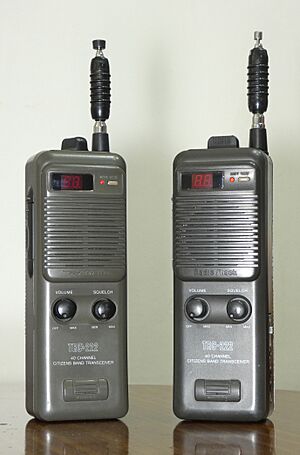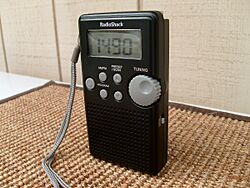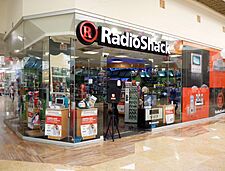RadioShack facts for kids
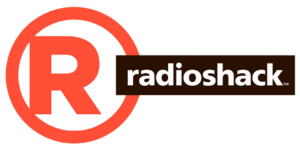
Logo used from 2013 to 2015 and since 2023
|
|
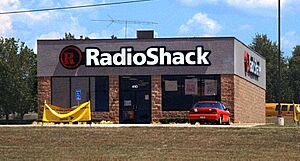
A typical free-standing RadioShack store in Texarkana, Texas (2006)
|
|
|
Formerly
|
Radio Shack Corporation (1921–1962) Tandy Corporation (1962–2000) RadioShack Corporation (2000–2015) General Wireless Operations Inc. (2015–2020) |
|---|---|
| Industry | E-commerce, retail |
| Founded | 1921 Boston, Massachusetts, US |
| Founders | Theodore and Milton Deutschmann |
| Headquarters | Fort Worth, Texas, US |
|
Number of locations
|
Approximately 400 authorized dealers in the US Various international locations |
|
Key people
|
Alex Mehr (CEO) |
| Products | Consumer electronics |
| Parent | General Wireless IP Holdings LLC (2015–2020) Retail ECommerce Ventures (2020–2023) Unicomer Group (2023–present) |
RadioShack is an American company that sells electronics. It started in 1921 by selling radio parts through mail order. In 1962, Tandy Corporation bought RadioShack. They changed the business to focus on selling electronics in small stores. These stores had staff who knew a lot about electronics.
RadioShack grew a lot and even started selling personal computers in the late 1970s. By the 1990s, they focused more on wireless phones. In 1999, RadioShack was at its biggest, with over 8,000 stores. However, they faced tough competition from larger stores.
In 2015, RadioShack had financial problems and filed for bankruptcy. A company called General Wireless bought its assets. In 2017, General Wireless also filed for bankruptcy. RadioShack then focused on selling products online. In 2023, the Unicomer Group took control of the worldwide RadioShack business.
Contents
How RadioShack Started
The Early Years: 1921-1962
Radio Shack was founded in 1921 by two brothers, Theodore and Milton Deutschmann. They wanted to sell equipment for amateur radio, also known as ham radio. Their first store was in Boston. They chose the name "Radio Shack" because it was a term for a small room on a ship where radio equipment was kept.
In 1939, the company released its first catalog. They also started selling high-quality music equipment. By 1954, Radio Shack began selling its own products under the brand name Realist. They later changed it to Realistic.
By the early 1960s, Radio Shack had nine stores and a large mail-order business. However, the company faced financial difficulties.
Tandy Corporation Takes Over
In 1962, Charles D. Tandy, who owned a leather goods company, saw potential in Radio Shack. He bought the company for US$300,000. At that time, Radio Shack was almost out of business.
Tandy's plan was to attract people who enjoyed hobbies. He opened smaller stores with knowledgeable staff. These stores mainly sold products under RadioShack's own brands. Tandy stopped the mail-order business and reduced the number of items sold. This strategy helped the company grow.
Charles D. Tandy, who led the company's growth, passed away in 1978.
Expanding Product Lines
In the 1980s, RadioShack started selling home telephones. This was after a change that allowed people to own their phones instead of renting them.
RadioShack also made many of its own products in its factories. By the early 1990s, Tandy was a major maker of personal computers. They even built hardware for other big companies. At one point, RadioShack was the largest electronics chain in the world.
In the 1990s, Tandy sold its computer manufacturing business. They also started to focus less on small parts and more on popular consumer electronics.
"Battery of the Month" Club
From the 1960s to the early 1990s, RadioShack had a "battery of the month" club. Customers could get one free Enercell battery each month with a special card. This offer brought many people into the stores.
Flavoradio: A Long-Lasting Product
One of RadioShack's most famous products was the AM-only Realistic Flavoradio. It was sold from 1972 to 2000, making it one of the longest-running radios ever. It came in fun colors like vanilla, chocolate, and strawberry.
CB Radio Popularity
RadioShack benefited greatly from the popularity of citizens band radio (CB radio) in the mid-1970s. At its peak, CB radio sales made up almost 30% of the company's income.
Early Home Computers
In 1977, RadioShack introduced the TRS-80. This was one of the first personal computers sold ready-to-use. It was a complete system when many other computers were sold as kits. Sales of the TRS-80 were much higher than expected.
RadioShack also offered computer lessons for kids in the early 1980s. They even had a comic book series called Tandy Computer Whiz Kids.
By 1982, RadioShack had over 4,300 stores. They also had more than 2,000 independent stores in smaller towns.
In the 1990s, RadioShack stopped making its own computers. They started selling computers from other companies like IBM and Compaq.
RadioShack Corporation: A New Era
In 2000, the company officially changed its name to RadioShack Corporation. They stopped using the Tandy name. Many of their own brands, like Realistic and Optimus, were also discontinued.
RadioShack tried to focus on selling wireless phones. This put them in direct competition with large electronics stores.
Customer Service Changes
For many years, RadioShack asked for customer names and addresses for mailing lists. This practice stopped around 2004.
In 2009, RadioShack worked with the Better Business Bureau to improve customer service. They created a website and put up signs in stores to help customers resolve issues.
"The Shack" Rebranding
In 2009, RadioShack tried to rebrand itself as "The Shack." This campaign helped increase sales of mobile products. However, it also meant less focus on their traditional electronics parts business.
Financial Challenges and Bankruptcy
From 2000 to 2011, RadioShack faced financial difficulties. Sales declined for many quarters. The company tried to close some underperforming stores, but faced challenges.
In February 2015, RadioShack filed for bankruptcy. They announced plans to close many stores. Customers were given a limited time to return items or use gift cards. The company also faced discussions about selling customer information as part of its assets.
RadioShack's New Beginnings
General Wireless Operations
In March 2015, a company called General Wireless Operations, Inc. bought 1,743 RadioShack stores. As part of the deal, RadioShack partnered with Sprint. Many RadioShack locations became co-tenants with Sprint, selling Sprint's wireless products.
The new owners emphasized that this was a completely new company. They stated that the old RadioShack did not return from bankruptcy.
However, General Wireless also faced financial problems. In March 2017, they filed for bankruptcy again. Many more RadioShack stores were closed or converted into Sprint-only locations. By May 2017, RadioShack announced plans to close most of its corporate stores and focus mainly on online sales.
In July 2017, Kensington Capital Holdings bought the RadioShack brand and other intellectual property.
Retail Ecommerce Ventures (REV)
In November 2020, Retail Ecommerce Ventures (REV) purchased RadioShack's intellectual property and remaining operations. This included about 400 independent dealers and its online sales.
In 2021, REV announced plans to use the RadioShack brand for a cryptocurrency platform called RadioShack DeFi. This platform allows people to exchange different digital currencies.
RadioShack Around the World
Canada
In 1986, Tandy Corp. created a separate company called InterTAN Inc. to manage its international stores, including those in Canada. InterTAN operated stores under the Tandy or RadioShack names.
In 2004, Circuit City bought InterTAN. The Canadian stores were later rebranded as "The Source by Circuit City." RadioShack briefly tried to re-enter the Canadian market but eventually closed its stores there.
Mexico
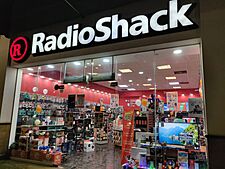
In 1986, Grupo Gigante started operating Radio Shack stores in Mexico. In 1992, they formed a joint company called Radio Shack de México with Tandy.
In 2015, Grupo Gigante bought full control of RadioShack de Mexico. This included all stores, warehouses, and brand names for use within Mexico. Even when RadioShack faced bankruptcy in the US, Grupo Gigante planned to expand the brand in Mexico.
Latin America & the Caribbean
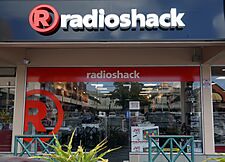
When RadioShack first filed for bankruptcy in 2015, the Unicomer Group bought the rights to use the RadioShack brand in Latin America and the Caribbean (except Mexico). Unicomer had been a RadioShack franchise owner since 1998.
Unicomer expanded RadioShack stores into many countries, including Honduras, Guatemala, Nicaragua, Trinidad, Jamaica, and Barbados. They also receive payments from independent franchised stores in other countries.
Middle East
The Egypt-based Delta RS for Trading bought the rights to the RadioShack brand for the Middle East and North Africa in 2015. They operate as Radio Shack Egypt. They opened their first franchised store in 1998.
Other Activities
Community Involvement
RadioShack has supported various community programs. In 2006, they helped the National Center for Missing & Exploited Children with a child identification program. They also supported United Way of America for disaster relief efforts. RadioShack promotes recycling rechargeable batteries and wireless phones in its stores.
Retail Partnerships
RadioShack has partnered with other retailers in the past. They opened small stores inside Blockbuster outlets and wireless kiosks in Sam's Club warehouses. They also had a partnership with Target to set up mobile phone kiosks.
No-Contract Wireless Service
In 2012, RadioShack partnered with Cricket Wireless to offer its own brand of no-contract wireless services. This service was stopped in 2014.
Cycling Team Sponsorship
In 2009, RadioShack became the main sponsor of a new cycling team called Team RadioShack. Famous cyclist Lance Armstrong was part of this team and featured in RadioShack's advertisements.
Images for kids



